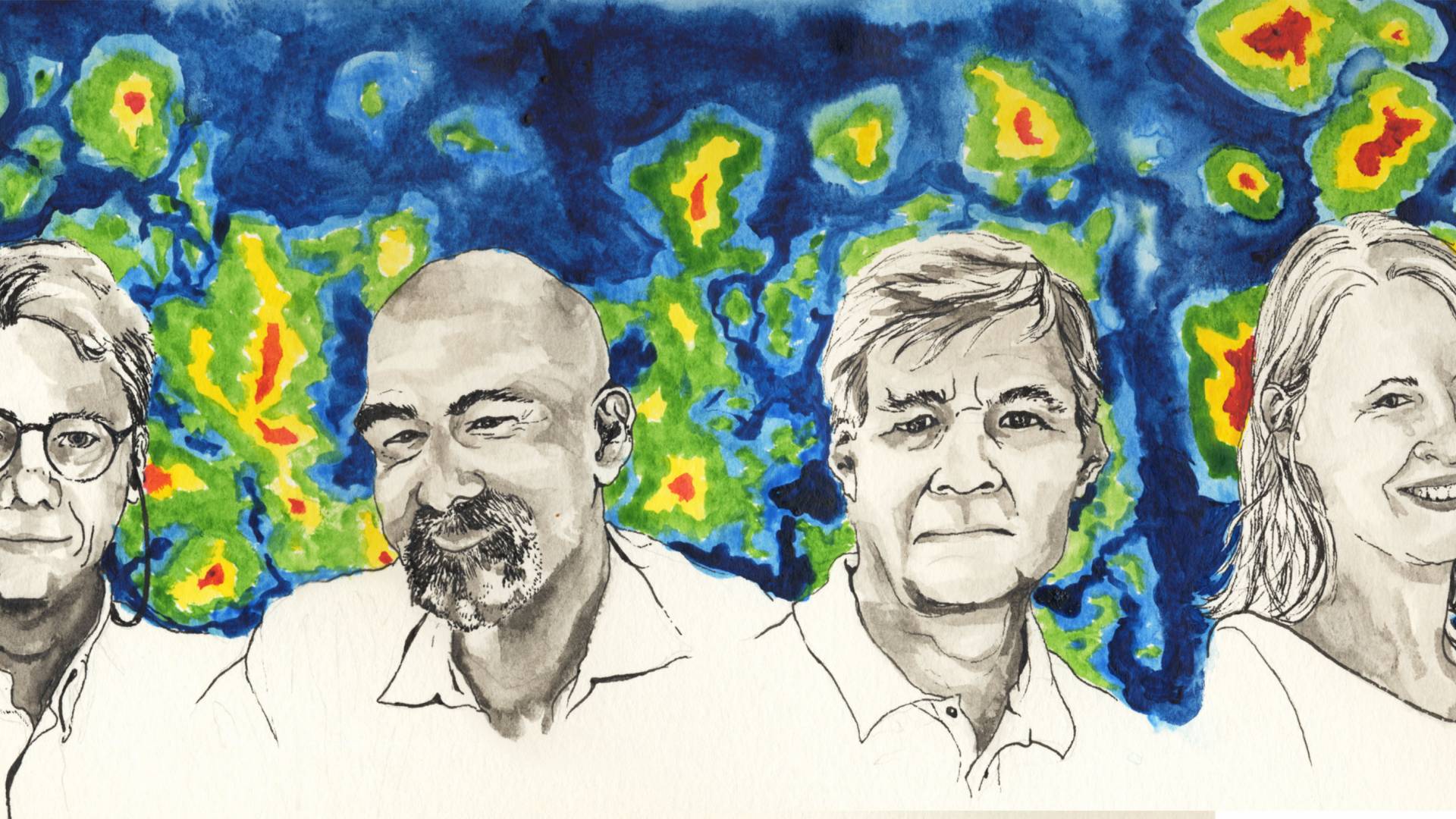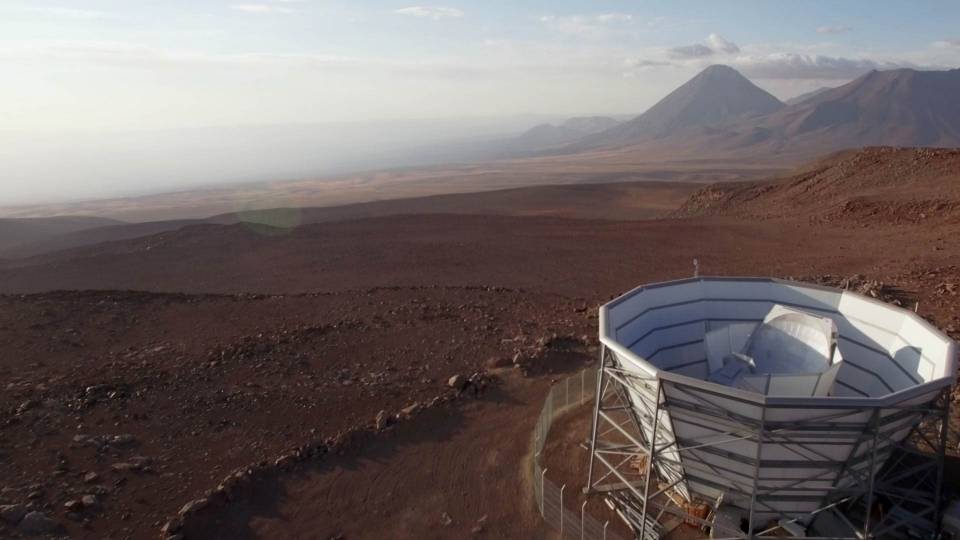From left: Princeton researchers Lyman Page, David Spergel, Norman Jarosik and Jo Dunkley were awarded the Breakthrough Prize in Fundamental Physics on Dec. 3 for their pioneering work on the Wilkinson Microwave Anisotropy Probe that generated a map of the early universe. They share the $3 million prize with the entire 27-member WMAP research team.
Seventeen current or former Princeton University researchers have been awarded the Breakthrough Prize in Fundamental Physics for their “detailed maps of the early universe that greatly improved our knowledge of the evolution of the cosmos and the fluctuations that seeded galaxies.”
Norman Jarosik, Lyman Page Jr. and David Spergel were publicly honored on Dec. 3 for their pioneering work on the Wilkinson Microwave Anisotropy Probe, the NASA satellite known as WMAP. They share the $3 million prize with Charles Bennett of Johns Hopkins University, Gary Hinshaw of the University of British Columbia, and the other 22 members of the WMAP team. That team includes Jo Dunkley, now a Princeton professor of physics and astrophysical sciences, and 13 former Princeton postdoctoral researchers and students.
“Somehow, we seem to have done it,” Spergel said in a video presented during the awards program. “We think we understand the physics that happened in the universe’s first moments.”
Jarosik is a senior research physicist and lecturer in physics, Page is the James S. McDonnell Distinguished University Professor in Physics, and Spergel is the Charles A. Young Professor of Astronomy on the Class of 1897 Foundation.
The new Breakthrough laureates received their honors at NASA Ames Research Center in Palo Alto, California, at a televised awards ceremony Sunday evening.
"Norman Jarosik, Lyman Page Jr. and David Spergel are brilliant physicists whose research has transformed our understanding of the age, shape, and evolution of the universe,” said Princeton University President Christopher L. Eisgruber, who attended the event with the three physicists.
“Their pioneering work has illuminated some of the most challenging topics in astrophysics, yielding dazzling insights that continue to shape the field today,” he said. “I am grateful for their contributions to the Princeton community, and I am thrilled that they have been recognized with this well-deserved honor."
The physics award was presented by Sam Altman, the president of the startup company seed funder Y Combinator, and Mayim Bialik, a neuroscientist and star of TV’s “Big Bang Theory.”
The experiment to measure the cosmic microwave background radiation — the signature of the Big Bang — began at Princeton more than a decade ago and involved a team of University contributors, including cosmologist David Wilkinson and the late physicist Robert Dicke. Originally known as MAP, the satellite was renamed WMAP to honor Wilkinson, who died in 2002.
NASA launched the WMAP satellite in 2001 toward the second Lagrange point of the Earth-sun system — one of the two spots where Earth and the sun exert equal gravitational pulls on an object — located about a million miles from Earth. From there, the satellite scanned the universe, mapping out tiny temperature fluctuations across the sky.
“To my surprise, we saw what we expected to see,” Spergel said in the video. “With WMAP, the tools we had were good enough to explain what the universe looked like 13.8 billion years ago, really for the first time, with high precision.”
WMAP’s “baby picture of the universe” revealed the hot, young universe at only 375,000 years old. Among many other discoveries, scientists interpreting WMAP’s nine years of data have determined that the universe is 13.77 billion years old and is composed primarily of dark energy, representing more than 70 percent of all matter.
In addition to Jarosik, Page, Spergel '82, Wilkinson and Dunkley, nine other members of the WMAP team participated in the research while graduate students or postdoctoral researchers at Princeton: Chris Barnes *98, Rachel Bean, Olivier Dore, Eiichiro Komatsu, Michele Limon, Mike Nolta *02, Hiranya Peiris *03, Kendrick Smith and Licia Verde. In addition, team members Stephan Meyer *80, Al Kogut '83, Greg Tucker *91 and Edward Wollack *94 all studied at Princeton.
The Breakthrough Prizes, first awarded in 2013, recognize scientists in the fields of Life Sciences (up to five per year), Fundamental Physics (up to one per year) and Mathematics (up to one per year) with $3 million prizes for each award. This year, seven Breakthrough Prizes were given, with the WMAP team sharing the sole prize in the Fundamental Physics category. In addition, up to three $100,000 New Horizons in Physics and up to three New Horizons in Mathematics Prizes are given out to early-career researchers each year.
Princeton biologist David Botstein and physicist Andrei Bernevig received Breakthrough Prizes in 2013 and 2015, respectively.
The Breakthrough Prizes were founded by Sergey Brin, Yuri and Julia Milner, Mark Zuckerberg and Priscilla Chan, and Anne Wojcicki. Selection committees composed of previous Breakthrough Prize laureates choose the winners.


